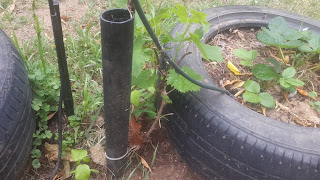Tried a few times in the past, both from seed and transplanted seedlings, with no success. The seeds grew into hair like tiny plants then died. The seedlings, packed into a 12 cell polystyrene tray, were transplanted after rudimentary separation in the expectation that I'd hill them when big enough. They didn't take long to die, either.
A few days ago, I spotted a tray of leek seedlings and couldn't resist them. This time I did the obvious, and Googled "transplanting leek seedlings". This resulted in Youtube videos and good articles on what needs to be done, i.e.:
Soak the contents of a cell in water to rinse out the potting medium, and then carefully separate out the roots. In my case, each cell contained between three and seven seedlings, averaging maybe five.
The next step:
Dib a series of holes, between 10 and 15cm apart, about 15cm deep. I started with a rake handle, but struggled, so ended up using my 1.8m crowbar.. My soil tends to stick to the sides of the dibber, so rocking it backwards and forwards and rotating it helps produce an open hole.
Drop the separated seedlings into each hole, or in the case of those with good root systems, push them in so they bottom out. There'll be a couple of cm of leaf sticking out the top.
Finally, carefully fill each hole with water using the watering can. As the water gets absorbed, the roots at the bottom get covered with some soil from the sides of the hole. If they don't, repeat.
Leave the holes as is - the idea is that as the leeks grow, their stems will fill the hole, which gradually gets covered over with soil.
I got 76 leek seedlings, a bit tedious to plant, but here's hoping.
Update 2016/11/29:
A bit of shrinkage but most doing OK. Looks like it's going to be a crop for the long haul...
Update 2017/01/10:
































